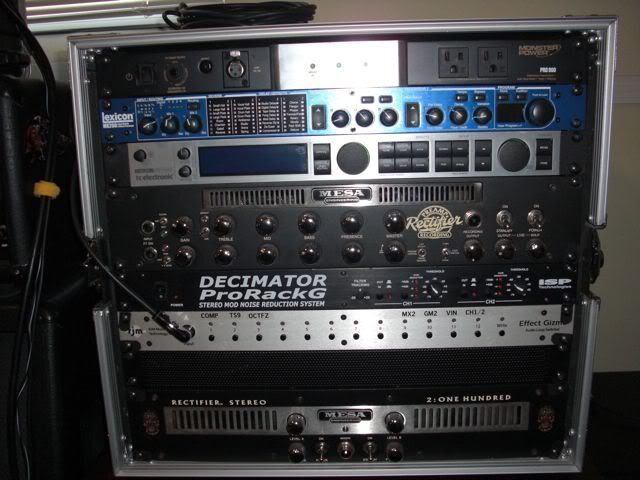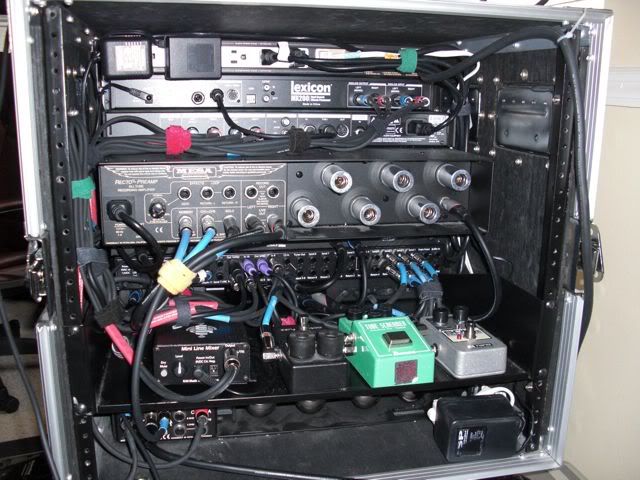In my rack, I have a G-Major 2 plus a lexicon MX200. I want to use a mini line mixer so the output of the MX200 is not processed by the G Major 2. I have the diagram illustrating this setup, and I understand how it works. However, I want to do something slightly different. In the wiring diagram, both processors are set to 100% wet, and the dry signal is carried from the Effect Gizmo output to the dry input of the mini line mixer. The effects in the G Major 2 do not sound as good using the killdry feature. Therefore, I want to use the mini line mixer to combine the outputs of the effects processors (which is simple to do), but I also want to have available an unprocessed signal when I do not want to use the processors. To make the problem more interesting, I want to do it with as few loops as possible. I have uploaded two jpegs with two possible ways of implementing the setup.
Fig. 1 uses three loops and, I think, does everything I want. This is one more loop than I would like to use since I want to save two loops for amp switching. With the figure 1 setup, I can have either effect processor on, both on, or both off and the dry signal out of loop 11. I believe I will always have to have loop 11 on to hear anything. The one question I have about this setup is signal integrity. For example, with loop 9 on, my signal will flow to the MX200 and into the line mixer and power amp. However, since the jacks are normalled and I do not have anything plugged into the return jack of loop 9, part of the signal will be sent to the output jack of loop 9. I know as long as I have loops 10 and 11 off, no signal will be sent to the send jacks of those loops. My question is do normalled jacks split the signal like a voltage divider or is the full strength of the signal sent to both jacks. In other words, will the signal integrity suffer in this setup.
Fig. 2 uses two loops and ground tip plugs to break the normalled connection. If I am understanding the operation of the Effects Gizmo correctly, then the Fig. 2 setup would only allow three options: MXR on/off, G Major 2 on/off, and dry signal on/off. For example, the grounding plug in loop 9 will prevent using the MX200 and G Major simultaneously. Would I get what I want by removing the ground plug from loop 9? This seems like the best option. With the ground plug removed from loop 9, I could use one effect processor, both effects processors, or just the dry signal. Again, will using the normalled feature of the jack this way degrade the signal?
I know this is long and twisty, so I thank you ahead of time. I just want to do this in the best way possible.


Ciro
Fig. 1 uses three loops and, I think, does everything I want. This is one more loop than I would like to use since I want to save two loops for amp switching. With the figure 1 setup, I can have either effect processor on, both on, or both off and the dry signal out of loop 11. I believe I will always have to have loop 11 on to hear anything. The one question I have about this setup is signal integrity. For example, with loop 9 on, my signal will flow to the MX200 and into the line mixer and power amp. However, since the jacks are normalled and I do not have anything plugged into the return jack of loop 9, part of the signal will be sent to the output jack of loop 9. I know as long as I have loops 10 and 11 off, no signal will be sent to the send jacks of those loops. My question is do normalled jacks split the signal like a voltage divider or is the full strength of the signal sent to both jacks. In other words, will the signal integrity suffer in this setup.
Fig. 2 uses two loops and ground tip plugs to break the normalled connection. If I am understanding the operation of the Effects Gizmo correctly, then the Fig. 2 setup would only allow three options: MXR on/off, G Major 2 on/off, and dry signal on/off. For example, the grounding plug in loop 9 will prevent using the MX200 and G Major simultaneously. Would I get what I want by removing the ground plug from loop 9? This seems like the best option. With the ground plug removed from loop 9, I could use one effect processor, both effects processors, or just the dry signal. Again, will using the normalled feature of the jack this way degrade the signal?
I know this is long and twisty, so I thank you ahead of time. I just want to do this in the best way possible.


Ciro



